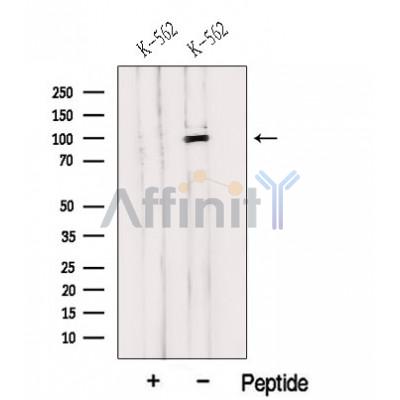HELLS Antibody - #DF12631
| Product: | HELLS Antibody |
| Catalog: | DF12631 |
| Description: | Rabbit polyclonal antibody to HELLS |
| Application: | WB IF/ICC |
| Reactivity: | Human, Mouse, Rat, Monkey |
| Prediction: | Pig, Bovine, Horse, Sheep, Rabbit, Dog, Chicken |
| Mol.Wt.: | 97 kDa; 97kD(Calculated). |
| Uniprot: | Q9NRZ9 |
| RRID: | AB_2845593 |
Related Downloads
Protocols
Product Info
*The optimal dilutions should be determined by the end user. For optimal experimental results, antibody reuse is not recommended.
*Tips:
WB: For western blot detection of denatured protein samples. IHC: For immunohistochemical detection of paraffin sections (IHC-p) or frozen sections (IHC-f) of tissue samples. IF/ICC: For immunofluorescence detection of cell samples. ELISA(peptide): For ELISA detection of antigenic peptide.
Cite Format: Affinity Biosciences Cat# DF12631, RRID:AB_2845593.
Fold/Unfold
FLJ10339; Helicase lymphoid specific; Hells; HELLS_HUMAN; LSH; Lymphoid specific helicase; Lymphoid-specific helicase; Nbla10143; PASG; Proliferation associated SNF2 like protein; Proliferation-associated SNF2-like protein; SWI/SNF2 related matrix associated actin dependent regulator of chromatin subfamily A member 6; SWI/SNF2-related matrix-associated actin-dependent regulator of chromatin subfamily A member 6;
Immunogens
A synthesized peptide derived from human HELLS, corresponding to a region within the internal amino acids.
Highly expressed in proliferative tissues such as adult thymus and testis, and expressed at lower levels in uterus, small intestine, colon, and peripheral blood mononuclear cells. Also expressed in neoplastic cell lines including those derived from myeloid and lymphoid leukemias.
- Q9NRZ9 HELLS_HUMAN:
- Protein BLAST With
- NCBI/
- ExPASy/
- Uniprot
MPAERPAGSGGSEAPAMVEQLDTAVITPAMLEEEEQLEAAGLERERKMLEKARMSWDRESTEIRYRRLQHLLEKSNIYSKFLLTKMEQQQLEEQKKKEKLERKKESLKVKKGKNSIDASEEKPVMRKKRGREDESYNISEVMSKEEILSVAKKNKKENEDENSSSTNLCVEDLQKNKDSNSIIKDRLSETVRQNTKFFFDPVRKCNGQPVPFQQPKHFTGGVMRWYQVEGMEWLRMLWENGINGILADEMGLGKTVQCIATIALMIQRGVPGPFLVCGPLSTLPNWMAEFKRFTPDIPTMLYHGTQEERQKLVRNIYKRKGTLQIHPVVITSFEIAMRDRNALQHCYWKYLIVDEGHRIKNMKCRLIRELKRFNADNKLLLTGTPLQNNLSELWSLLNFLLPDVFDDLKSFESWFDITSLSETAEDIIAKEREQNVLHMLHQILTPFLLRRLKSDVALEVPPKREVVVYAPLSKKQEIFYTAIVNRTIANMFGSSEKETIELSPTGRPKRRTRKSINYSKIDDFPNELEKLISQIQPEVDRERAVVEVNIPVESEVNLKLQNIMMLLRKCCNHPYLIEYPIDPVTQEFKIDEELVTNSGKFLILDRMLPELKKRGHKVLLFSQMTSMLDILMDYCHLRDFNFSRLDGSMSYSEREKNMHSFNTDPEVFIFLVSTRAGGLGINLTAADTVIIYDSDWNPQSDLQAQDRCHRIGQTKPVVVYRLVTANTIDQKIVERAAAKRKLEKLIIHKNHFKGGQSGLNLSKNFLDPKELMELLKSRDYEREIKGSREKVISDKDLELLLDRSDLIDQMNASGPIKEKMGIFKILENSEDSSPECLF
Predictions
Score>80(red) has high confidence and is suggested to be used for WB detection. *The prediction model is mainly based on the alignment of immunogen sequences, the results are for reference only, not as the basis of quality assurance.
High(score>80) Medium(80>score>50) Low(score<50) No confidence
Research Backgrounds
Plays an essential role in normal development and survival. Involved in regulation of the expansion or survival of lymphoid cells. Required for de novo or maintenance DNA methylation. May control silencing of the imprinted CDKN1C gene through DNA methylation. May play a role in formation and organization of heterochromatin, implying a functional role in the regulation of transcription and mitosis (By similarity).
Nucleus.
Note: Closely associated with pericentric heterochromatin.
Highly expressed in proliferative tissues such as adult thymus and testis, and expressed at lower levels in uterus, small intestine, colon, and peripheral blood mononuclear cells. Also expressed in neoplastic cell lines including those derived from myeloid and lymphoid leukemias.
Belongs to the SNF2/RAD54 helicase family.
Restrictive clause
Affinity Biosciences tests all products strictly. Citations are provided as a resource for additional applications that have not been validated by Affinity Biosciences. Please choose the appropriate format for each application and consult Materials and Methods sections for additional details about the use of any product in these publications.
For Research Use Only.
Not for use in diagnostic or therapeutic procedures. Not for resale. Not for distribution without written consent. Affinity Biosciences will not be held responsible for patent infringement or other violations that may occur with the use of our products. Affinity Biosciences, Affinity Biosciences Logo and all other trademarks are the property of Affinity Biosciences LTD.


